

Growth Mindset Video. Growth Mindset: A Driving Philosophy, Not Just a Tool. Picture a high school ELA honors class full of amazing kids who came up through the grades without any struggling, kids who thrive in schools that believe these students would do just fine.

It was a class of mine, students who felt initially uncomfortable but were ultimately able to come together and study Kurt Vonnegut's Slaughterhouse-Five, a novel that presented content and literacy challenges the students weren't used to. How about my son, who entered first grade last year as five-year-old, not because I'm a crazy, achievement-driven parent, but because we had just moved from New York to Massachusetts, which define cutoff ages differently?
We thought to put him in with his age group, but the district saw that he'd do better in first grade (he actually tested past second), and his new teacher ran her literacy program using flexible grouping so that all the kids could continually excel as was appropriate. Positive Psychology Resources, Happiness, Tips and Techniques. Positive Psychology Resources, Happiness, Tips and Techniques.
Eight Steps Towards a More Satisfying Life Sonja Lyubomirsky, University of California.
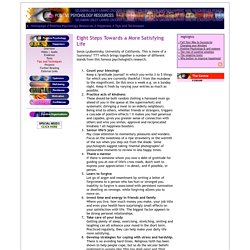
This is more of a ? Positive Psychology Resources, Happiness, Tips and Techniques. 3 Blessings Exercise Our brain tends to ignore what goes well and it focuses by default on what might go wrong.

Martin Seligman and others have devised and used a simple technique to address this, called the three blessings exercise. So the three blessings exercise demands that you focus your attention, as you end your day, on three things that went well and why they went well. These three don? T have to be earthshattering: they can be as small as a beautiful flower you looked at.
Learned Optimism. Learned Optimism By Martin E.P.
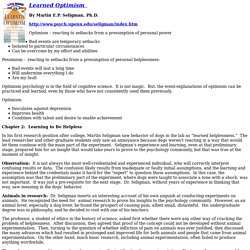
Seligman, Ph.D. Learned Optimism: Martin Seligman on Happiness, Depression, and the Meaningful Life. By Maria Popova What 25 years of research reveal about the cognitive skills of happiness and finding life’s greater purpose.
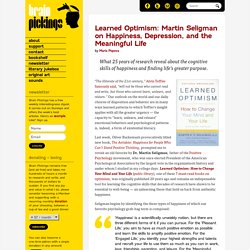
“The illiterate of the 21st century,” Alvin Toffler famously said, “will not be those who cannot read and write, but those who cannot learn, unlearn, and relearn.” 3things Home. 35 Service Projects for Kids. Here is a list of service projects and opportunities for kids to volunteer within their community that will empower kids with responsibility, engage their compassion, and offer them the chance to affect the lives of others.

Service projects to serve the elderly, service projects working with younger children, service projects that help the environment… locally and globally, kids can make a difference! 1. Make Valentine’s for Senior Citizens. 2. Collect sleep-away camp items for Camp Dreamcatcher, a program for children whose lives have been affected by HIV/AIDS.
Eight Habits that Improve Cognitive Function. Digital games are incapable of giving the entire brain a full workout.
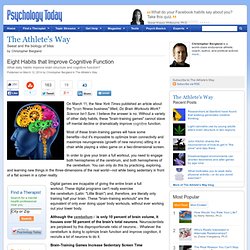
These digital programs can't really exercise the cerebellum (Latin: "Little Brain") and, therefore, are literally only training half your brain. These "brain-training workouts" are the equivalent of only ever doing upper body workouts, without ever working out your lower body. Although the cerebellum is only 10 percent of brain volume, it houses over 50 percent of the brain's total neurons. Neuroscientists are perplexed by this disproportionate ratio of neurons...
Whatever the cerebellum is doing to optimize brain function and improve cognition, it recruits a lot of neurons to do it. Brain-Training Games Increase Sedentary Screen Time. Building Brain Literacy in Elementary Students. Practice Makes Perfect For many students, the brain isn't a hot topic of conversation.
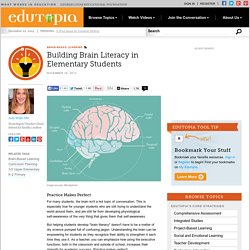
This is especially true for younger students who are still trying to understand the world around them, and are still far from developing physiological self-awareness of the very thing that gives them that self-awareness. But helping students develop "brain literacy" doesn't have to be a matter of dry science pumped full of confusing jargon. Understanding the brain can be empowering for students as they recognize their ability to strengthen it each time they use it. How thinking affects feelings. This material is also available in a PDF format: How thinking affects feelings [279KB]pdf Understanding that what we think affects how we feel and how we behave helps children and adults learn effective ways of managing emotions.
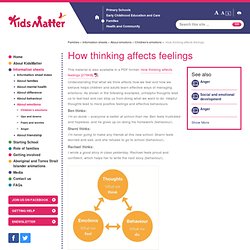
As shown in the following examples, unhelpful thoughts lead us to feel bad and can stop us from doing what we want to do. Helpful thoughts lead to more positive feelings and effective behaviours. Ben thinks:I’m so dumb – everyone is better at school than me. 1925: the Isolator helmet by Hugo Gernsback. Emotions and the Brain. Neuroplasticity. Adventures in Positive Psychology. A major part of learning to deal with our feelings is being able to label and identify our emotions.

It can be difficult to connect with our emotional state if we don’t have awareness about the feelings we’re having. Character Strengths, Personal Development: VIA Character > Reports, Courses & Resources > 340 Ways. Acquisition and use of knowledge I. Curiosity [interest, novelty-seeking, openness to experience]: Curiosity is taking an interest in all of ongoing experience. It involves actively recognizing and pursuing challenging opportunities and seeking out new knowledge. Curiosity can be broken down into three categories: interest, novelty seeking, and openness to new experience. It is this strength that drives individuals to make discoveries and to explore the boundaries of human knowledge. 8-Bounce-back-Teaching-resilience-to-young-people-HelenGrath. Our research - Suicide prevention - Research. Suicide is the most common cause of death in Australians aged 15-44 years.
Australian young people are more likely to take their own life than die from motor vehicle accidents or skin cancer. Every year 400,000 Australians experience suicidal thoughts, 65,000 make suicide attempts, 35,000 are admitted to hospital for suicide-related injuries and 2,500 die. In Australia, the financial costs have been estimated at $17.5b, or 1% of GDP. Suicide is recognised as a public health crisis both in Australia and around the world. Whilst recent statistics indicate that the number of Australian suicides have dropped slightly we know that suicide rates are highly volatile and reactive to environmental events such as unemployment rates and economic adversity. Put simply, the aim of CRESP is to save lives by. Mission-australia-youth-survey-mental-health-report-june-2014 (1) One in five young people struggling with mental illness. One in five young Australians are likely to be experiencing mental illness, and less than 40% are comfortable seeking professional help, according to our new report released in partnership with the Black Dog Institute.
The Youth Mental Health Report, which will be officially launched today by the NSW Mental Health Commissioner John Feneley, also found the rate of mental illness among young Australians aged 15-19 was much higher among females and Aboriginal and Torres Strait Islanders, while young people with a disability were also overrepresented. Mission Australia CEO Catherine Yeomans said the findings highlight the increasing vulnerability of Australian youth, and the need for greater supports to help them on their journey into adulthood. The confronting findings in this report illustrate the significant challenges many of our young people are facing when it comes to psychological distress and mental health issues. Key findings include: More information. Www.tandfonline.com/doi/pdf/10.1080/17439760.2014.920408.
Positive education: Creating flourishing students, staff and schools. By Dr Suzy Green MAPS, Coaching Psychology Unit, University of Sydney, and Positive Psychology Institute, Dr Lindsay Oades, Director, Australian Institute of Business Well-Being, University of Wollongong, and Paula Robinson, Positive Psychology Institute This article provides an introduction to the field of ‘positive education' and demonstrates how applied positive psychology, which includes evidence-based coaching, can inform and assist schools to develop and maintain the optimal functioning of students and staff. We encourage those working in or with schools to think strategically in creating positive education programs that support and sustain a positive school climate and culture for whole school wellbeing. Www.mtbhs.sa.edu.au/docs/positive_education_resources/Adelaide_-_Intro_for_principals_-_Well-being_&_Education.pdf.
Redirect Notice. Positive Education - Success Integrated. What is Positive Psychology? • psychology is focused on what's wrong with people & how to fix it - a disease or deficit model; &• positive psychology is focused on what's right with people (building strengths) & how they can thrive - a well-ness model. Positive Psychology has an evidence base in neuro-science and is structured around the well-being theory developed by Dr Martin Seligman.
According to Dr. Seligman, well-being has five measurable elements (P.E.R.M.A.) that count toward it: What is Positive Psychology? What is Positive Education? - Geelong Grammar School. Successful schools start with healthy minds. Safe Schools Hub. Mihaly Csikszentmihalyi: Flow, the secret to happiness. The Neuroscience of Good Coaching. Good coaches get results, respect, and awards—just ask the three managers recently inducted into the Baseball Hall of Fame. But what makes a coach or mentor good? One school of thought says they should hold their mentees to specific performance benchmarks and help them reach those benchmarks by targeting their personal weaknesses. But new research suggests a different tack—namely, to nurture a mentee’s strengths, aspirations for the future, and goals for personal growth.
Indeed, studies suggest that this positive approach is more effective at helping people learn and change; for instance, it helps train business school students to be better managers, and it is more effective at getting patients to comply with doctors’ orders. A recent study indicates why this more positive approach gets better results, using brain scans to explore the effects of different coaching styles. Martin Seligman: The new era of positive psychology.
When I was president of the American Psychological Association,they tried to media-train me,and an encounter I had with CNNsummarizes what I'm going to be talking about today,which is the eleventh reason to be optimistic.The editor of Discover told us 10 of them,I'm going to give you the eleventh. Kintsugi. Tea bowl repaired with the Kintsugi method. Dr. Dan Siegel - Explains Mirror Neurons in Depth. Baby Cries When Mom Sings. Honesty Shouldn't Go Unrewarded. Science of Character - Let It Ripple. The Science of Character (8 mins) explores the neuroscience and social science that proves that we can shape who we are, and who we want to be. The film was part of the global Character Day 2015 (Sept 18). Character Strengths - Let It Ripple. Character Strengths Development: VIA Institute on Character. Steven Bradbury - Last Man Standing - Road to Gold.
Phil Hansen: Embrace the shake. The happiest man alive? Could not load plugins: File not found 'I'm Free To Be Me' - 2012 Tropfest Finalist "Dancing Man" Tommy Franklin stars in the Tropfest documentary described as a "story of self redemption. " 16, 2013 He may have been dubbed the "happiest man alive", but dancing sensation Tommy Franklin assures he "doesn't shit gold nuggets". Apple - Think Different Commercial.